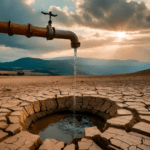Groundwater wells supply about 120 million Americans with drinking water and play a crucial role in agriculture. In some regions, when groundwater levels fall, deeper drilling is used to address issues like low water pressure. While this approach can be effective, it’s important to consider the area’s conditions and potential long-term effects. A study of nearly 12 million U.S. wells showed that deeper wells are drilled more frequently as groundwater levels change, highlighting the need for balanced water management strategies.
Exploring some of the challenges and limitations that may arise when drilling before deciding to do so is helpful.
These limitations don’t make drilling a poor choice, but they highlight the importance of understanding whether it fits your water needs. Here are some key considerations that may affect the success of drilling deeper wells:
- High Costs:Drilling deeper wells can involve substantial costs. For example, domestic wells may cost tens of thousands of dollars in places like California, with agricultural wells often requiring even more investment. This financial aspect can be challenging for some homeowners and farmers, especially when other, more budget-friendly solutions might meet their needs.
- Increased Energy Consumption:Extracting water from deeper sources requires more energy. The additional depth means pumps must work harder. Over time, this can lead to a larger environmental footprint and higher operational costs.
- Risk of Dry Wells:Deeper drilling can sometimes lead to dry wells, especially in areas where groundwater resources are already under stress. As more water is extracted from deeper levels, the natural flow of water into rivers and streams may also be disrupted, further contributing to regional water shortages.
Given these potential limitations, it’s worth exploring other solutions that may offer a more immediate, cost-effective, and sustainable way to increase water pressure and yield without drilling deeper.
When Might Drilling Be the Right Solution?

In certain situations, drilling a deeper well is not only necessary but the most effective option. Whether due to changes in groundwater levels, increased water demand, or specific environmental conditions, drilling can provide access to new water sources that would otherwise be out of reach. When well drilling is done with careful planning and consideration, it can be a long-term solution that meets both residential and agricultural needs.
For homeowners or farmers experiencing water shortages or significant drops in water pressure, drilling deeper can be the key to unlocking a more reliable water supply. Here are some instances when drilling is the right choice:
- Water Table Has Dropped:In regions where groundwater levels have fallen, accessing deeper water reserves may be the best way to maintain a steady water supply. This is especially common in areas that have experienced long-term droughts or where the population has grown significantly, putting more strain on existing resources.
- Existing Well is Too Shallow:Older or shallow wells may no longer provide enough water to meet current household or farming needs. Drilling a deeper well can help tap into larger or more consistent aquifers that were not previously accessible.
- Poor Water Quality at Current Depth:The water quality in shallower aquifers can sometimes degrade over time due to contamination or high mineral levels. Drilling deeper can allow you to reach cleaner, higher-quality water more suitable for drinking and irrigation.
- Local Geological Conditions Favor Deeper Wells:In some areas, the geological makeup may favor deeper wells. Drilling deeper can be a wise investment if the underlying bedrock or soil layers are conducive to holding large quantities of water at greater depths.
Sustainable Alternatives to Well Drilling
Although deeper well drilling can be a solution for some, it’s not always the most practical option to increase well water pressure or yield. Several sustainable alternatives are available for those who face the limitations of deeper drilling or simply want to explore less invasive and more cost-effective options. These alternatives are designed to enhance the performance of your current well system without requiring the significant financial investment or environmental impact that often comes with drilling.
By optimizing your existing resources, these solutions provide a reliable, long-term water supply that minimizes the strain on both your well and the surrounding groundwater. Here are a few alternative approaches that homeowners and farmers can consider when looking to increase well water pressure without drilling:
Well Manager Solutions: Maximizing Existing Well Output
One of the most effective and environmentally friendly alternatives to drilling is the Well Manager system. This solution is specifically designed to optimize the performance of your existing well, ensuring a reliable water supply even in low-yield situations.
- Affordability:The Well Manager system provides a more budget-friendly way to increase well water pressure compared to the significant financial outlay of drilling. It offers an accessible solution for homeowners and farmers who need better water pressure but want to avoid the high costs of deeper drilling.
- Well Protection:The system prevents overtaxing your current well by carefully timing water extraction and maintaining a consistent water level. This means that you can enjoy increased water pressure without the risk of overpumping or damaging the well.
- Efficiency:Well Manager enhances the efficiency of your well by ensuring that it operates at its full potential, providing a steady water supply without running dry. This can be particularly beneficial for wells yielding as little as 0.25 gallons per minute.
- Green Alternative:Installing a Well Manager system helps avoid the environmental disruption of drilling or hydrofracking. It’s a self-contained, sustainable option that requires minimal setup and is simple enough to be a do-it-yourself solution, making homeowners feel empowered to manage their water supply.
Ready for a Steady Water Supply?
Before resorting to the costly and potentially unsustainable option of drilling a new well, consider exploring the Well Manager solution and other alternatives. Choosing a method that optimizes your current resources helps maintain a consistent water supply without the financial or environmental challenges of drilling deeper. Contact our experts today for a free consultation and discover how to increase water pressure and sustainably meet your water needs.






